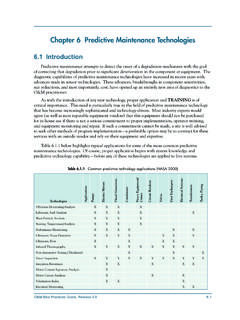Transcription of Review of Failures of Photovoltaic Modules
1 Report IEA-PVPS T13-01:2014 Review of Failures of Photovoltaic Modules Ultraviolet fluorescence image of a cracked solar cell in a Photovoltaic module. Courtesy of Marc K ntges, Institute for Solar Energy Research Hamelin. INTERNATIONAL ENERGY AGENCY Photovoltaic POWER SYSTEMS PROGRAMME Performance and Reliability of Photovoltaic Systems Subtask : Review of Failures of Photovoltaic Modules IEA PVPS Task 13 External final report IEA-PVPS March 2014 ISBN 978-3-906042-16 -9 Primary authors: Marc K ntges, Institute for Solar Energy Research Hamelin, Emmerthal, Germany Sarah Kurtz, Corinne Packard, National Renewable Energy Laboratory, Golden, CO, USA Ulrike Jahn, T V Rheinland Energie und Umwelt GmbH, Cologne, Germany Karl A. Berger, Austrian Institute of Technology GmbH, Energy Department, Vienna, Austria Kazuhiko Kato, National Institute of Advanced Industrial Science and Technology, Tsukuba, Japan Thomas Friesen, SUPSI ISAAC, Canobbio, Switzerland Haitao Liu, Institute of Electrical Engineering, Chinese Academy of Sciences, Beijing, China Mike Van Iseghem, Electricit de France, EDF R&D, Moret-sur-Loing, France Contributing authors.
2 John Wohlgemuth, David Miller, Michael Kempe, Peter Hacke National Renewable Energy Laboratory, Golden, CO, USA Florian Reil, Nicolas Bogdanski, Werner Herrmann T V Rheinland Energie und Umwelt GmbH, Cologne, Germany Claudia Buerhop-Lutz The Bavarian Centre for Applied Energy Research, W rzburg, Germany Guillaume Razongles Institut National de l Energie Solaire, INES-CEA, Le Bourget-du-Lac, France Gabi Friesen, SUPSI ISAAC, Canobbio, Switzerland This report is supported by Austrian Federal Ministry for Transport, Innovation and Technology (BMVIT) under FFG contract No. 828105, Chinese Academy of Sciences (CAS), German Federal Ministry for Economic Affairs and Energy under Contract (BMWi), Swiss Federal Office of Energy (SFOE) and Department of Energy under Contract No. DE-AC36-08-GO28308 with the National Renewable Energy Laboratory (NREL) I Table of Contents 1 Foreword .. 1 2 Executive summary.
3 2 3 Introduction .. 4 4 Definitions .. 10 Definition of a PV module failure .. 10 PV module Failures excluded by definition .. 10 Important PV module Failures due to external causes .. 12 Clamping .. 12 Transport and installation .. 13 Quick connector failure .. 14 14 Definition of safety failure and safety categories .. 16 Definition of power loss failure and power loss categories .. 17 Definition of a defect .. 18 Definition of PV module parts .. 18 5 Basics of measurement methods used to identify Failures .. 20 Visual inspection .. 20 Visual inspection in accordance with IEC PV standards .. 21 Documentation of visual Failures in the field .. 23 I-V curve .. 26 Introduction of the important I-V curve parameters .. 26 Series resistance and shunt resistance .. 27 28 Effect of Failures on the I-V curve .. 29 thermography .. 33 thermography under steady state conditions.
4 33 Pulse thermography .. 36 Lock-in thermography .. 37 Electroluminescence .. 41 UV fluorescence .. 47 Signal transmission method .. 49 6 Failures of PV Modules .. 53 Review of Failures found in all PV Modules .. 55 Delamination .. 55 Back sheet adhesion 56 II Junction box failure .. 58 Frame breakage .. 58 Review of Failures found in silicon wafer-based PV Modules .. 61 EVA discolouration .. 61 Cell cracks .. 62 Snail tracks .. 67 Burn marks .. 71 Potential induced degradation .. 73 Disconnected cell and string interconnect ribbons .. 82 Defective bypass diode .. 85 Review of Failures found in thin-film Modules .. 88 Micro arcs at glued connectors .. 88 Shunt hot spots .. 89 Review of specific Failures found in CdTe thin-film PV Modules .. 92 Front glass breakage .. 93 Back contact degradation .. 94 7 Adapting testing methods to failure mechanism for PV Modules .
5 96 Mechanical loads caused by transport .. 96 Determination of resonance frequencies of single PV Modules .. 97 Transport and environmental testing of silicon wafer-based PV Modules in a shipping stack .. 97 Transport testing of single silicon wafer-based PV Modules .. 99 Mechanical loads caused by snow .. 104 Testing for UV degradation of PV Modules .. 106 UV preconditioning for PV Modules .. 107 Performance degradation of PV Modules .. 108 Ammonia Testing .. 110 Tests performed on crystalline Si glass/foil PV Modules .. 112 Tests performed on non-glass Modules .. 113 Testing for potential induced degradation of crystalline silicon PV Modules . 114 Extended IEC testing in the 116 Test results from extended testing .. 118 Accelerated testing and field experience .. 121 8 Conclusions .. 123 ANNEX A: Module condition checklist .. 127 1 1 Foreword The International Energy Agency (IEA), founded in November 1974, is an autonomous body within the framework of the Organization for Economic Co-operation and Development (OECD) which carries out a comprehensive programme of energy co-operation among its member countries.
6 The European Union also participates in the work of the IEA. Collaboration in research, development and demonstration of new technologies has been an important part of the Agency s Programme. The IEA Photovoltaic Power Systems Programme (PVPS) is one of the collaborative R&D Agreements established within the IEA. Since 1993, the PVPS participants have been conducting a variety of joint projects in the application of Photovoltaic conversion of solar energy into electricity. The mission of the IEA PVPS programme is: To enhance the international collaborative efforts which facilitate the role of Photovoltaic solar energy as a cornerstone in the transition to sustainable energy systems. The underlying assumption is that the market for PV systems is rapidly expanding to significant penetrations in grid-connected markets in an increasing number of countries, connected to both the distribution network and the central transmission network.
7 This strong market expansion requires the availability of and access to reliable information on the performance and sustainability of PV systems, technical and design guidelines, planning methods, financing, etc., to be shared with the various actors. In particular, the high penetration of PV into main grids requires the development of new grid and PV inverter management strategies, greater focus on solar forecasting and storage, as well as investigations of the economic and technological impact on the whole energy system. New PV business models need to be developed, as the decentralised character of photovoltaics shifts the responsibility for energy generation more into the hands of private owners, municipalities, cities and regions. The overall programme is headed by an Executive Committee composed of representatives from each participating country and organisation, while the management of individual research projects (Tasks) is the responsibility of Operating Agents.
8 By late 2013, fourteen Tasks were established within the PVPS programme, of which six are currently operational. The overall objective of Task 13 is to improve the reliability of Photovoltaic systems and subsystems by collecting, analysing and disseminating information on their technical performance and Failures , providing a basis for their assessment, and developing practical recommendations for sizing purposes. 2 The current members of the IEA PVPS Task 13 include: Australia, Austria, Belgium, China, EPIA, France, Germany, Israel, Italy, Japan, Malaysia, Netherlands, Norway, Spain, Sweden, Switzerland, Turkey and the United States of America. This report concentrates on the detailed description of PV module Failures , their origin, statistics, relevance for module power and safety, follow-upfailures, their detection and testing for these Failures .
9 The report mainly focuses on wafer-based PV Modules . Thin-film PV Modules are also covered, but due to the small market share of these types of PV Modules reliable data is often missing. The author team also focuses on types of PV module Failures which are not specific for one special manufacturer and have a broader relevance. The editors of the document are Marc K ntges, Institute for Solar Energy Research Hamlin, Emmerthal, Germany (DEU) and Ulrike Jahn, T V Rheinland Energie und Umwelt GmbH, Cologne, Germany (DEU). The report expresses, as nearly as possible, the international consensus of opinion of the Task 13 experts on the subject dealt with. Further information on the activities and results of the Task can be found at: 2 Executive summary One key factor of reducing the costs of Photovoltaic systems is to increase the reliability and the service life time of the PV Modules .
10 Today s statistics show degradation rates of the rated power for crystalline silicon PV Modules of [Jordan11]. To increase the reliability and the service life of PV Modules one has to understand the challenges involved. For this reason, the international Task 13 expert team has summarized the literature as well as their knowledge and personal experiences on actual Failures of PV Modules . The target audience of this work is PV module designers, PV industry, engineering lines, test equipment developers, testing companies, technological research laboratories, standardisation committees, as well as national and regional planning authorities. In the first part, this document reports on the measurement methods which allow the identification and analysis of PV module Failures . Currently, a great number of methods are available to characterise PV module Failures outdoors and in labs.






